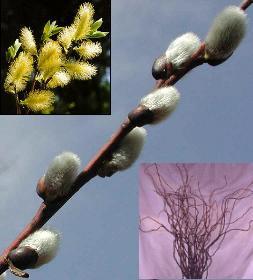January
2003
Did you know that the first medicine with
salicylic acid (the precursor of aspirin) extracted from the bark of the
willow?

|
|
Willow
(Salix spp.)
|
Willow
(Salix spp.)
Salix is
the botanical name for a group of deciduous (leaf-losing) trees and
shrubs, which are mostly hardy. They are found wild throughout Europe,
northern Africa, Asia, and North America; a few are found in the
Southern Hemisphere. Some grow naturally in the arctic and alpine
regions. The common name for this group and also the old Latin name is,
Willow. Willow comprises more than 300 shrubs or trees of the
Salicaceae family and varies in height from a few inches to 70-80 ft
(21-24 meters). The
botanical name of the Willow 'Salix' comes from the Celtic word "sal"-
meaning near, and "lis" - meaning water, because the Willow
grows in the moist ground particularly on the banks of rivers and
streams.
Most Willows grow rapidly and are fairly
short-lived. Their
young stems are flexible and strong, but the old branches are soft and
brittle and liable to storm damage. Willows may form large bushes,
prostrate shrubs, trees of medium height with the typical tree outline,
and trees with hanging branches; there are all sorts of intermediates.
The leaves of most Willows are long, slender and oblong or lance-shaped. Willow
flowers are borne in early spring, either before or after the leaves.
Male (staminate) and female (pistillate) flowers are produced on
separate trees. Both types are borne in catkins (a long cluster of
flowers), which are carried erectly on the branch. The male flowers are more noticeable than the female
flowers,
the former being a yellow color when mature, though some kinds are
reddish. The female flowers are ordinarily green or gray-green. Very
rarely are male or female flowers produced on the same tree. Seeds
ripen during May and June and are whitish colored; they are produced
sparingly in cottony fiber. Willows are very easy to grow and love
moist soil in full sun.
Some of the more common types to be found
are: the
Black Willow (Salix nigra) named for its dark bark. The tall White Willow
(S. alba) is commonly found in cultivated ground and is probably a
descendant of the White Willow of Europe. This is the largest of the
Willows growing to over 75 ft (23 meters) with a girth of some 20 ft
or more (6 meters); its ash-gray silky leaves give the tree its white
appearance. The Weeping Willow (S. babylonica) grows from 40 to 50
feet high. Is believed to have
originated in China and often appears in Chinese art. Its beauty makes
it a favorite ornamental tree in gardens and parks, but while it is
widely cultivated for its beauty, it has practically no commercial
value.
An interesting tree called the Permanent Wave
Tree or curly willow is S. Matsudana var. tortuosa. This tree has spiraling twisted
branches and twigs; it grows 30 feet or so. Its spiraling branches are
vey decorative and are used widely for indoors decorations. A popular shrub or tree is
the Pussy Willow S. discolor also known as Goat Willow, usually grown as a shrub along
the banks of streams. In the spring it
produces charming, silky soft male catkins. It is especially favored
for cutting for indoor decoration. For early bloom inside, branches of
these plants may be cut and stood in containers of water in a sunny
window anytime after the middle of January. Soon, the "pussies"
develop and make an attractive display for a considerable time. Perhaps the most commercial of the Willows are those of the genus
called Osiers and a significant industry has developed from the use of
its wood. The Osiers include the Common Osier or Basket Willow (S.
viminalis) and the Purple Willow (S. purpurea). They furnish
pliable shoots and twigs that are used in Europe for basket making and
wickerwork.
The wood of the Willow is white, soft and light but also
tough and elastic, and is not given to splintering when subjected to
strain. It is used for making tool handles, shipping containers,
baseballs and cricket bats, and because it is relatively nonflammable
for the brake blocks of railway stock. Hippocrates of Kos, the father of all
doctors, prescribed a juice extracted from the bark of the willow tree for fever and
pain, and also for labour pains. The active substance in this juice, which does in fact ease
pain, is - as we know today - salicylic
acid (the precursor of aspirin). Its name gives a clue as to its
origin, being derived from the Latin word for willow: salix.
The Willow is particularly rich in folklore and
myths, and
has many associations with greek mythology. In Ancient Greece willow
was sacred to fertility. The Willow was also sacred to poets, for the sound of the wind
through the Willow is said to have a potent influence on the mind
which results in inspiration. Orpheus the Greeks most celebrated poet
is said to have received his gifts of eloquence and communication from
the Willow by carrying its branches with him while journeying through
the Underworld.
Source:
http://www.botany.com/salix.html
http://www.controverscial.com/Willow.htm
http://www.aspirin.com/world_of_aspirin_en.html
|
